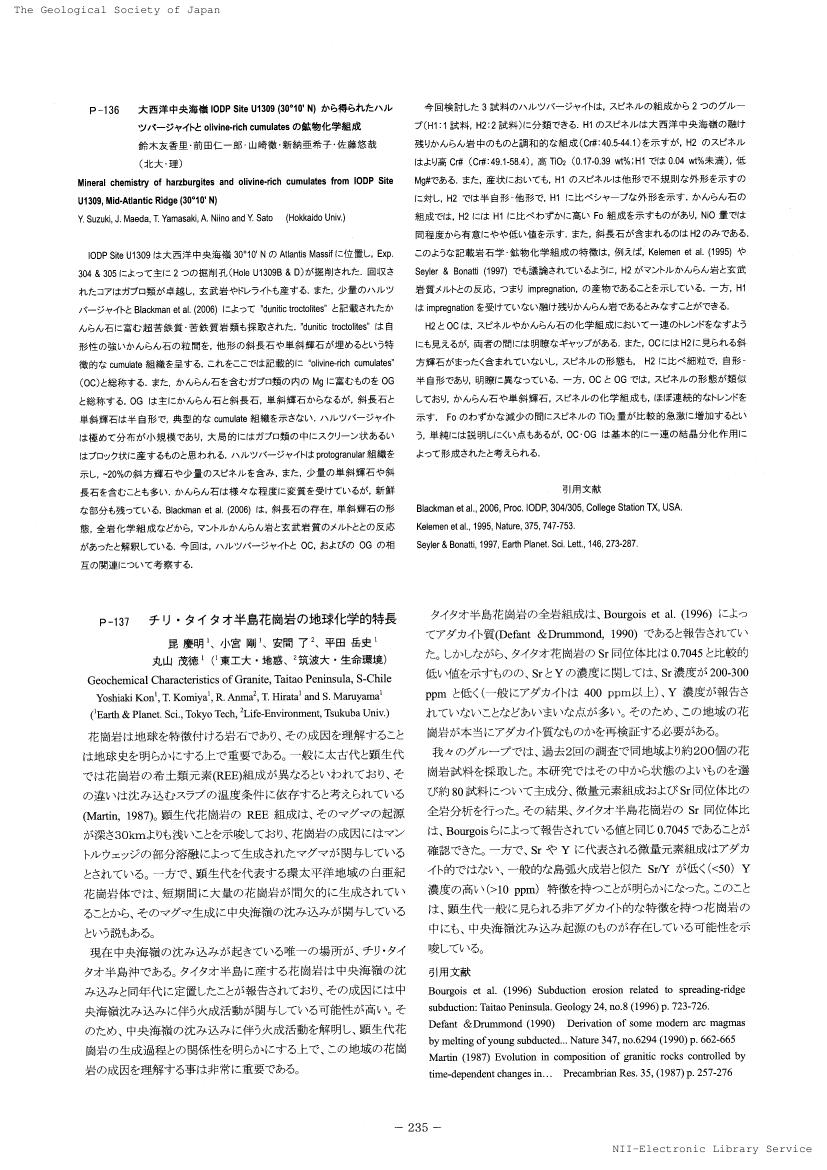5 0 0 0 OA プロト伊豆―マリアナ島弧の衝突付加テクトニクス
- 著者
- 平田 大二 山下 浩之 鈴木 和恵 平田 岳史 李 毅兵 昆 慶明
- 出版者
- 公益社団法人 東京地学協会
- 雑誌
- 地学雑誌 (ISSN:0022135X)
- 巻号頁・発行日
- vol.119, no.6, pp.1125-1160, 2010-12-25 (Released:2011-03-17)
- 参考文献数
- 142
- 被引用文献数
- 8 10 5
This paper reviews the geology, petrology, and tectonics of the Proto-Izu-Mariana arc against the Honshu arc, Japan, since 15 Ma, to formulate current topics related to the Pacific-type orogeny. Since the first pioneering work by Sugimura (1972), which placed the plate boundary on-land Japan north of the Izu peninsula collision-accretion tectonics of the Proto-Izu-Mariana arc against the Honshu arc started to be extensively investigated through multi-disciplinary methods. Aoike (1999) proposed a comprehensive scenario of five successive accretions of Proto-Izu to the present, with all bounded by top- and bottom-faults since 15 Ma. Oroclinal bending of the Honshu arc began simultaneously with the collision and indentation of the Proto-Izu arc, as is well documented by the Neogene paleomagnetic declination of sedimentary rocks in the Kanto district (Niitsuma et al., see summary, 1989). The entire Izu-Mariana arc is subducting without any accretion now under Honshu, as is well documented by seismic tomography imaging by Hasegawa et al. (see Hasegawa et al., 2010). Tanzawa Tonalite–Trondhjemite–Granodiolite (TTG) pluton intruded into the already-accreted Tanzawa Group at 4 Ma (Tani et al., 2010), resulting in a contact metamorphic aureole ranging from amphibolite through greenschist to zeolite facies at a depth of ca. 10 km, and tectonically denudated along the Kan-nawa fault to be exposed on the surface by 1.0 Ma. The Proto-Izu-Mariana arc was built on the Pre-Paleogene, presumably Cretaceous MORB crust on which boninitic and fractionated silicic lava flows accumulated since 48 Ma, which is older than the bending of the Hawaii–Emperor seamount chain at 43 Ma. Hence, we need another plate off Proto-Ogasawara arc, called North New Guinea plate (Seno, 1985), and ridge subduction underneath Ogasawara arc to initiate subduction magmatism. Both calk-alkali rock series (CA) and coeval blueschist–eclogite rocks are exposed along the inner wall of the Izu–Mariana trench. This strongly suggests that extensive tectonic erosion occurred, resulting in the coexistence of two rock units that were formed 100-150 km from each other horizontally, i.e., rocks on the volcanic front and rocks on the descending oceanic slab. Petrogenesis of juvenile crust and TTG rocks are being debate with two models: basaltic arc magma fractionation (Kawate and Arima, 1998) and delaminated mafic lower crust (Nakajima and Arima, 1998). In the latter model, a difficulty is derived from density at the Moho depth and small size of delaminated residue. Instead, extensive tectonic erosion that transports not only the upper crust but also the lower mafic crust together with parts of the descending slab could be more plausible than these two models in order to present a thinner mafic lower crust.
- 著者
- 昆 慶明 小宮 剛 安間 了 平田 岳史 丸山 茂徳
- 出版者
- 一般社団法人 日本地質学会
- 雑誌
- 日本地質学会学術大会講演要旨 第113年学術大会(2006高知) (ISSN:13483935)
- 巻号頁・発行日
- pp.235, 2006-09-08 (Released:2017-08-21)
1 0 0 0 OA 中央海嶺沈み込み起源の花崗岩から得られたジルコンのHf同位体比
- 著者
- 昆 慶明 平田 岳史 小宮 剛 安間 了 丸山 茂徳
- 出版者
- 一般社団法人日本地球化学会
- 雑誌
- 日本地球化学会年会要旨集 2008年度日本地球化学会第55回年会講演要旨集
- 巻号頁・発行日
- pp.300, 2008 (Released:2008-09-06)
『生命』、『海』、『プレートテクトニクス』と並んで、『花崗岩質大陸地殻』の存在は地球を特徴付ける要素であり、その生成プロセスを明らかにすることは地球史を解明する上で非常に重要である。 本研究では、LA-MC-ICPMSを用いてタイタオ半島花崗岩から分離したジルコンの局所Hf同位体比測定を行った。その結果ジルコンの177Hf/176Hfは、現在沈み込む海洋地殻の値と誤差範囲で一致し、およそ0Maのモデル年代が得られた。このモデル年代は花崗岩マグマの原岩がマントルから分離した年代を反映することから、タイタオ半島花崗岩マグマの原岩は古いモデル年代を持つ下部地殻ではなく、沈み込む海洋地殻であることが確かめられた。
